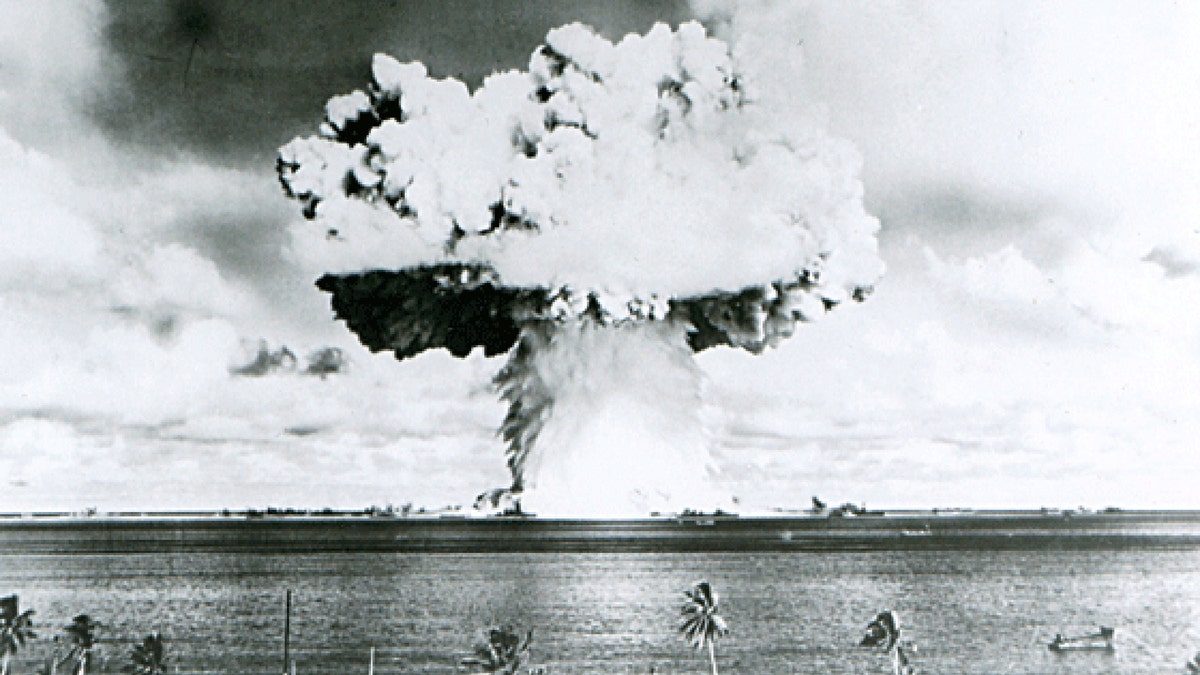
This U.S. Navy handout image shows Baker, the second of the two atomic bomb tests, in which a 63-kiloton warhead was exploded 90 feet under water as part of Operation Crossroads, conducted at Bikini Atoll in July 1946 to measure nuclear weapon effects on warships. (REUTERS/U.S. Navy/Handout via Reuters)
In the Cold War era, the deterrence approach could be described as the bigger the nuclear bomb, the better. Are new mini nukes the right solution instead for today’s threat of a nuclear war?
President Trump is currently in South Korea for talks having just left a visit with a similarly concerned Japanese leadership about North Korea’s nuclear threats.
Earlier this year, Trump mandated a thorough review of America’s nuclear posture and ballistic missile defense. So back in the States, some of the brightest minds in the Department of Defense have been focused on this Review that will provide the President with recommendations and options relating to the threat of nuclear war.
WILL THE US UNLEASH REVOLUTIONARY 'LIGHTNINGSTRIKE' DRONE ON FUTURE ENEMIES?
Over the next decade, the Congressional Budget Office estimates that about $400 billion dollars will be invested in modernizing and maintaining U.S. nuclear forces.
The U.S. has a vast and formidable nuclear arsenal and many methods from submarines to fighter jets to deliver those bombs. But much of the nuke program dates back to the Cold War and is feeling its age. The review could provide ideas to adapt, modernize and innovate so the United States is even more prepared to tackle today’s nuclear threats.
If there were to be a nuclear attack, then it is vital that Trump has the very best options at his disposal to deliver a just response.
Enter mini nukes?
The review has been very closely held with little hinted as to what the recommendations and options will be – but we do know that last year, the Defense Science Board’s “Seven Defense Priorities for the New Administration” report recommended that the Pentagon consider focusing on more low-yield nuclear weapons – aka “mini nukes.”
Aat a recent Mitchell Institute event, Vice Chairman of the Joint Chiefs of Staff Air Force General Paul Selva delivered incisive remarks on the subject. He noted is important to provide the President with options and “Everything is on the table in the review, from conservative strategic approaches to radical new approaches.”
The Vice Chairman’s remarks triggered a buzz with many speculating on what the future could hold for “radical options.”
Smaller, variable, more “tactical” nukes are a strong contender for development by the military in the modernization process. Amidst the hubbub, these weapons found themselves nicknamed mini-nukes. In the simplest of terms, the idea is that the power of these nuclear weapons could be adjustable.
Think of it as a “dial a yield” bomb…this mini nuke could be dialed up for stronger destruction or dialed down for less.
The mini nukes factor
If mini nukes are recommended by the review, then Trump may soon have at his disposal the ability to target a specific neighborhood with a nuclear bomb - and leave the rest of a city undamaged by the explosion.
Each mini nuke could be tailored to the specific, necessary scale of destruction. For example, it could target and annihilate say a square mile – without the areas outside that mile being hit by the explosion.
More accurate nuclear strikes with an adjustable nuke warhead could reduce collateral damage and radioactive fallout.
Of course, radiation and other related threats would still expand well beyond the blast radius. The explosion would be far more restrained, but the damage to human life and the environment would reach beyond the blast limits.
PODCAST: FIND OUT THE TRUTH BEHIND THE DRONE HEADLINES WITH THIS INTELL OPERATIVE
So how could these new mini nukes be made?
There are two primary ways this capability could be developed. Some of the military's current nuclear weapon stockpile could be adapted or the military can also develop mini nukes from square one.
The military already has some very successful initiatives underway to make nukes smaller and more precise. For example, adjustments to the B61 bombs, enhanced with advanced tech like steerable fins, have already proven very successful.
WILL COMBAT VEHICLES USE URINE FOR FUEL?
The U.S. President must have options
President Trump already has an array of staggeringly powerful nuclear weapons at his disposal and it will only be more enhanced and advanced with the modernization program.
Variable yield mini nukes could potentially provide more flexibility and options.
Advocates for mini nuke type capability have argued that if the U.S. is attacked by North Korea with a nuclear weapon, then Trump needs the ability to launch a calibrated, targeted nuclear attack in response.
A variable yield mini nuke could give the President the means to launch a more contained strike with less radioactive fallout.
Selecting this low-yield, tailored weapon instead of a massive high yield nuke, Trump could eliminate a specific dangerous threat without destructively impacting the entire region - including allies like South Korea and Japan.
PODCAST: MEET THE NAVY SEAL WHO BECAME HOLLYWOOD STAR IN TRANSFORMERS
Responding “in kind”
Another argument for new variable, mini nukes is that it would give the President further options to respond “in kind”. For example, it is believed that North Korea could possibly unleash a nuclear weapon at the scale of about 100-kilotons – that’s enough to potentially destroy a city. The U.S. possesses thousands of nukes in a wide range of destructive power.
If a country attacked the U.S. with a 100-kiloton nuclear weapon, then the mini nuke would give Trump the option of responding with a nuke adjusted to the same strength. This would be a response “in kind” with a similar low yield attack, rather than a high yield weapon.
Avoiding civilian casualties
This sort of adjustable mini nuke could also potentially enable the US to better discriminate by specifically targeting perpetrators and reducing civilian casualties.
High-yield nuclear weapons possess immense, destructive power that could yield unimaginable horrific destruction and countless deaths. Nukes are the most horrific of weapons.
If the most terrible scenario happens and the US needs to deploy a nuke, mini nukes may be one solution to ensuring this catastrophic weapon is precise and would allow Trump to avoid vast civilian casualties as much as possible.
To put this in context, rather than unleashing a nuclear weapon that could kill a country’s entire population in example, Trump would have the option to use a tailored mini nuke to target a dangerous military installation instead.
Mini nukes are not without detractors, though.
There is no shortage of critics with a range of concerns including the argument that it is exactly the mini nuke’s precision and the reduction of destruction that makes the option tempting. And since it is more tempting, it is more likely therefore that a nuclear weapon will be used.








































